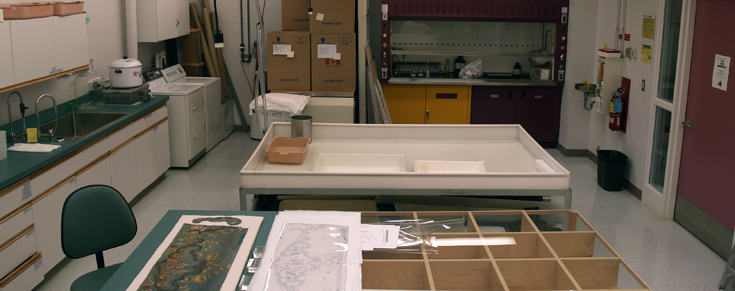
Before July 2009, collection staffing was envisioned as a three-member professional team that consisted of a curator, a collections manager, and a conservator. Through the efforts of community volunteers and students, both in the classroom and as volunteers, and with the support of University of Alberta’s Museums, this barebones yet efficient system was able to address the basic needs of its students, faculty, researchers, and our local community.
By July 2010, restructuring of some academic programs, budgetary issues, and the departure and arrival of new staff members generated considerable change. The collections manager became a part-time position as the person holding this position, Vlada Blinova, started to teach apparel design and textile history classes in our program. The curator, Anne Bissonnette, also started incorporating the use of artifacts in her classroom to co-curate exhibitions with undergraduate and graduate students. Their in-depth ability to understand clothing and textiles in terms of structure and history has lead to an increase in the use of artifacts in the classroom. It is also likely that students feel more comfortable approaching these two faculty members and thus make use of the collection in their research throughout their programs of study and beyond. Nonetheless, this greatly affects our artifacts and the need to care for their well being.
Because budget cutbacks often affect ancillary enterprises such as the Collection first, our number one priority lies in establishing an endowed conservator position. This will allow us to maintain our international standards of care and properly address the needs of artifacts for storage and display. In addition to stabilization and treatment of artifacts, the conservator will take over some of the tasks the collection manager used to do, such as condition reports, photography and preparation of artifacts for loans. As well, the conservator could teach textile conservation courses, which would enrich undergraduate and graduate education programming. Although we used to offer some textile conservation courses, we can no longer do so without a conservator.
The reinstatement of this position will address four of our five key objectives. In addition to maintaining our levels of care and excellence in collections management, it will make possible the stabilization and mounting of artifacts to enable photography, which will contribute to making pieces visually accessible via our online database. While larger museums may have extensive curatorial and administrative staff, most usually have one conservator who may have one fellow as an assistant. Thus, with one conservator who has access to a great collection and the infrastructure readily available, leadership in the field is achievable. Depending on the interest and skills of the individual, projects like the development of museum quality mannequins using full-body scanners could also advance the field considerably. Lastly, if we plan to develop travelling exhibitions using our artifacts, having a conservator is indispensable.
To learn more and give to the Textile Conservator Endowment, click here.
*
